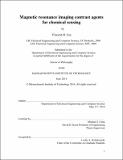| dc.contributor.advisor | Michael J. Cima. | en_US |
| dc.contributor.author | Liu, Vincent Hok | en_US |
| dc.contributor.other | Massachusetts Institute of Technology. Department of Electrical Engineering and Computer Science. | en_US |
| dc.date.accessioned | 2014-09-19T19:37:05Z | |
| dc.date.available | 2014-09-19T19:37:05Z | |
| dc.date.copyright | 2014 | en_US |
| dc.date.issued | 2014 | en_US |
| dc.identifier.uri | http://hdl.handle.net/1721.1/89844 | |
| dc.description | Thesis: Ph. D., Massachusetts Institute of Technology, Department of Electrical Engineering and Computer Science, 2014. | en_US |
| dc.description | This electronic version was submitted by the student author. The certified thesis is available in the Institute Archives and Special Collections. | en_US |
| dc.description | Cataloged from student-submitted PDF version of thesis. | en_US |
| dc.description | Includes bibliographical references. | en_US |
| dc.description.abstract | Magnetic resonance imaging (MRI) is frequently used for examining the human body. MRI contrast agents currently used in the clinic assist physicians in locating problematic areas, but other tools are needed to interrogate the chemical environment of these areas once found. The fast clearance rate of contrast agents, in particular, makes quantitative assessment of local tissue with MR difficult. This thesis focuses on the development of solid MRI contrast agents designed for longterm, quantitative monitoring of local metabolites. Two types of contrast agents are described in this thesis. Contrast agents sensitive to oxygen were made by encapsulating low molecular weight siloxanes in a polydimethylsiloxane (PDMS) matrix. The PDMS matrix is biocompatible and prevents clearance of the contrast material. The longitudinal relaxation time, T1, of these agents is proportional to the amount of dissolved oxygen in the material and is indicative of local oxygen tension. A microparticulate formulation of these agents was tested in a rat model and was shown to be stable for up to one month in vivo. These results suggested that the encapsulated agents enjoyed an order of magnitude improvement in stability over a simple liquid contrast agent injection. Contrast agents sensitive to changes in pH were made of a polymerized hydroxlethylmethacrylate (HEMA) hydrogel and used with the microresonator sensor previously developed in the Cima Lab. These sensors reversibly detected changes in pH in flowing liquid for up to three weeks, and detected the different pH of a tumor compared to control locations. | en_US |
| dc.description.statementofresponsibility | by Vincent H. Liu. | en_US |
| dc.format.extent | 141 pages | en_US |
| dc.language.iso | eng | en_US |
| dc.publisher | Massachusetts Institute of Technology | en_US |
| dc.rights | M.I.T. theses are protected by copyright. They may be viewed from this source for any purpose, but reproduction or distribution in any format is prohibited without written permission. See provided URL for inquiries about permission. | en_US |
| dc.rights.uri | http://dspace.mit.edu/handle/1721.1/7582 | en_US |
| dc.subject | Electrical Engineering and Computer Science. | en_US |
| dc.title | Magnetic resonance imaging contrast agents for chemical sensing | en_US |
| dc.type | Thesis | en_US |
| dc.description.degree | Ph. D. | en_US |
| dc.contributor.department | Massachusetts Institute of Technology. Department of Electrical Engineering and Computer Science | |
| dc.identifier.oclc | 890131806 | en_US |
